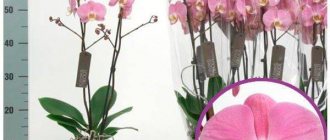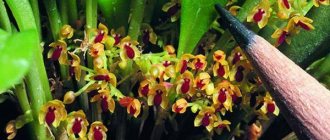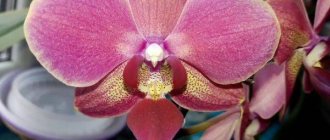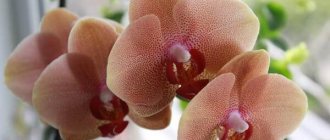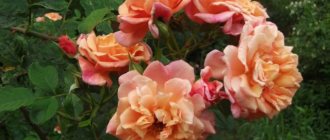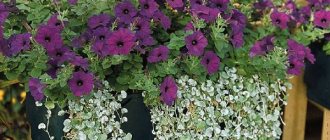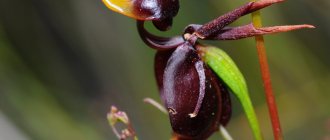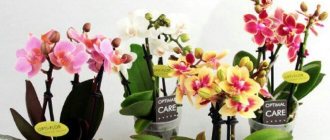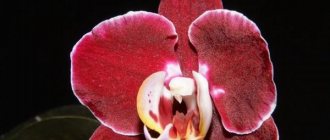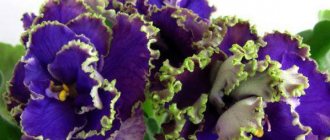In this article we will take a detailed look at the following varieties of phalaenopsis: Kaleidoscope, Karin Aloha, Cascade and Kimono, and also get acquainted with the basics of caring for them. In the meantime, a short lyrical digression and a historical excursion into the world of beautiful tropical beauties...
You have a phalaenopsis in your house . And it doesn't matter how. Here are just some of the possible reasons:
- We've been wanting to buy it for a long time, long-awaited and desired. How long can you look at the beauty of your friends?
- Good gift. I really want it to continue to bloom;
- Or they could buy it for the company. Friends took it and recommended it. And also a sale. They promised to tell me how to take care of it. And we begin to collect information about them ourselves.
There is a lot of talk about phalaenopsis now. A cut flower in an ampoule with liquid in a neat transparent box is a very common gift for March 8th.
Phalaenopsis is now breaking down the wall of doubt and uncertainty:
- Flower shops offer a good selection;
- There are lovers who can share their experience of growing these beauties . Positive. And not just for one year. Without greenhouses, but on window sills and loggias;
- Amazing shapes and colors of large and small flowers;
- Small and miniature in height. And solid standard ones;
- Blooming almost constantly . And intermittently;
All this only fuels interest in these plants. And if you saw compositions from several copies while visiting, you yourself will want to have something similar. Or the same. By calling on the Internet for help, you unwittingly become involved in the process of orchid growing;
You can buy phalaenopsis now without any problems (although not so cheap.) Caring for it is not as difficult as it seemed. They used to be the property of the consuls.
From the history of phalaenopsis. Selected facts:
- Its description was published back in 1825 by botanist Karl Ludwig Blume. And you already know that the name of the plant means “ moth-like ,” “Butterfly-like”;
- If you speak Greek well, you will do without translators. If you don’t own it, it doesn’t matter. “Falaina” – moth, “opsis”-like;
- Their natural habitats in nature are Southeast Asia, the Philippines, Indonesia, and northern Australia. Wet and warm forests of mountains and plains.
Interesting!
- Civilized Europe first saw them only after 1850. But the interest and boom in phalaenopsis has become dangerous for natural habitats;
- So, orchid hunters practically destroyed an entire valley with pale pink orchids. It was Schiller's phalaenopsis that fell under the Inquisition. To please Europe and make money;
- Confucius also highly appreciated the presence of orchids: “Meeting a good person is comparable to entering a room full of orchids.”
The structure of phalaenopsis:
- Short stem and long, wide, dark green leaves. Only 5-7. Length – from 4-5 cm to 30 cm. It grows only upwards. Flower stalks and aerial roots grow from the axils of these leaves;
- Two or three strong peduncles. In many they are branched ;
- Multi-colored flowers . The size and shapes are not the same;
- Their number ranges from 2-3 to hundreds. More often there are 12-20 pieces on one plant ;
- Unusual roots for flowers. Greenish and covered with velamen. Visible for inspection and control.
On the left in the figure is a diagram of the structure of a monopodial orchid, which is phalaenopsis.
The structure of the sympodial Cattleya orchid.
Let's look at phalaenopsis varieties with different flower sizes and unusual colors: Kaleidoscope, Karin Aloha, Cascade, Kimono.
Popular varieties
Of the huge number of varieties, we list the names of the most famous and original ones.
Black butterfly. A very beautiful and unusual phalaenopsis, the color of which, depending on the lighting, varies from rich dark burgundy with a chocolate tint to almost black.
The petals have a pointed shape, the one located in the core (lip) is white-yellow, with a burgundy edge. There are up to 8 flowers on the peduncle, reaching 5 cm.
Diamond King. It has bright burgundy flowers with a light border (diameter - 8 cm). The petalia closer to the center is white, with small leopard print patches, similar to freckles.
Manhattan. Currently, this hybrid is not registered, it only has a trade name. The flowers are soft pink or soft lilac, strewn with many small dotted burgundy inclusions, reminiscent of a marble pattern, with a bright orange or yellow center.
Pavarotti. The variety is known for its dense, almost monochromatic flowers of a rich wine shade. The diameter of the flowers is up to 8 cm.
Valencia. A rather rare variety of large phalaenopsis, growing up to 60 cm in height (including peduncle). The sepals and petals are snow-white, the lip is large, yellow inside and white outside. The center is deep burgundy, with an orange rim. Flowering period - up to 8 months.
Kimono. The color of the flowers is mottled purple, with a whitish-yellow border. The veins and tongue are darker, burgundy, the center is yellow-raspberry. They reach 7 cm in diameter.
Phalaenopsis has a huge variety of varieties
Legato. A hybrid with an unusual range of colors: on 2 peduncles reaching a height of up to 60 cm, flowers of soft pink, peach, golden-lilac pearl color appear twice a year and bloom for more than 8 weeks. Closer to the center, the silky petals have dark specks. The core is bright orange.
Separately, it is worth considering peloric orchids.
Pelorik is not a variety of orchid. This is the name given to plants that have non-standard bud shapes. Modification occurs as a result of mutation. Most often, petals grow together, as a result of which the bud does not open completely; sometimes different sepals or petals grow, taking the shape or shade of a lip.
A flower from monosymmetric (having 1 axis of symmetry) turns into radially symmetric, with several axes of symmetry.
Preparation
It is necessary to understand how to properly plant a sakura tree at home so that it takes root and can bloom. It is because of the beautiful flowering that many people grow this crop at home. It is worth considering that the aroma in the apartment is quite strong, so if you have allergies, it is not recommended to grow this tree in your apartment. Find out more about the preparatory stage for planting sakura.
Pot shape
It is strongly recommended that you take your pot selection seriously. Here are a few things to keep in mind:
- it is required that it has a drainage system;
- you need to choose oval or square shaped pots;
- The size of the pot should initially be only 5–7 cm in diameter, and then it should be increased by 2–3 cm every 2–3 years.
Important. Sakura can have different shapes during growth
If you do not trim, the center of gravity will shift. Then the plant may fall. To reduce the likelihood of such a problem occurring, expanded clay is laid out as a drainage system. It is quite heavy and does not allow the plant to overhang and fall over time.
How to choose soil?
You can easily find suitable soil in specialized stores. However, some gardeners prefer to do it themselves. The substrate must be correctly selected for the plant to feel good.
Here's what you'll need to use:
- river sand;
- clay;
- lava;
- pumice;
- humus.
Reference. For normal growth and abundant flowering, sakura requires a large amount of minerals. Therefore, it is highly recommended to constantly feed the soil during watering. To do this, use specialized fertilizers that can be purchased in stores.
In what conditions to grow?
Sakura bonsai is considered a relatively unpretentious plant. Therefore, it is easy to grow at home even for beginners.
However, it is necessary to consider several factors that affect the growth and health of the crop:
- The plant is thermophilic. This means that during the hottest part of the day it is recommended to store it in the sun. Then you can get beautiful and abundant flowering.
- In the off-season and winter, it is worth placing the pot on the south side.
- Sakura needs cool air and direct sunlight, which most bonsai plants cannot tolerate.
- The air temperature should be from 15 to 27 degrees.
- You need to be careful about watering. The soil should be moist, but not too moist. Otherwise, the tree will quickly die.
If you create all the conditions correctly, you can achieve beautiful and abundant flowering, which will delight the gardener.
Names of the best groups
Hybrids
Hybrids or mixes bring together a huge number of phalaenopsis of the most diverse, often unusual colors, which are bred both on the basis of varietal plants and as a result of crossing already obtained hybrids.
Here are some of them:
Anaconda
Anaconda. A flower up to 20 cm high with a delicate aroma and slightly rough leaf plates, along which vertical relief stripes run from the growing point to the end. The diameter of the flowers, which have a rich, bright yellow tint, does not exceed 6 cm. The surface of the petals is covered with a circular pattern of burgundy-colored specks, larger at the base, and the flower lip is also burgundy.
Mukalla
Mukalla. It has branching fleshy roots of a gray-green color and from 4 to 8 smooth green leaves of an asymmetrical oval shape, the length of which reaches 30 cm and the width is 10–12 cm.
The plant has from 1 to 4 peduncles 35–51 cm high. On them, medium-sized (4–5.5 cm) flowers with petals of a bright purple or lilac-violet hue and a red or dark red lip are located symmetrically on both sides. Flowers bloom sequentially, starting from the base, over 2–4 days.
Monaco
Monaco. Multifloral hybrid 45–55 cm high with sandy or grayish-brown petals, a white center and a yellow lip with a white tip. This orchid can have from 2 to 4 flower stalks.
Big Lip
Big lip, which means “big lips”. It got its name because of the large, unfolded, almost flat flower lip of a complex figured shape. This subspecies has several peduncles reaching a height of 70–80 cm, dense rich green leaves and large (up to 12 cm in diameter) flowers.
Golden
Phalaenopsis golden is a subspecies whose varieties are characterized by yellow shades of inflorescences, from lemon to golden. A plant with thick roots and large leaves blooms several times a year for two months, producing 2-3 flower stalks 75 cm tall. You can learn about popular varieties of golden phalaenopsis of the Golden group here.
Sogo
Sogo brings together varieties of phalaenopsis that belong to variegated plants, that is, those whose foliage is unevenly colored and is most often white-green, green-violet or green-red. The flowers of Sogo varieties are usually variegated, with stripes, specks or specks on a purple, white, yellow or lilac background, but monochromatic ones are also found.
Multiflora is a group of multi-flowered phalaenopsis hybrids with branching peduncles (up to 3 pieces) 60 cm high, producing up to 25 inflorescences. The leaves of representatives of this subspecies have a rich green color and reach a length of up to 35 cm. The adult plant itself looks like an airy flower bouquet. What colors does multiflora come in and how to care for it, read here.
Graceful varieties of phalaenopsis: Kaleidoscope, Karin Aloha, Cascade, Kimono
In this article we will take a detailed look at the following varieties of phalaenopsis: Kaleidoscope, Karin Aloha, Cascade and Kimono, and also get acquainted with the basics of caring for them. In the meantime, a short lyrical digression and a historical excursion into the world of beautiful tropical beauties...
You have a phalaenopsis in your house . And it doesn't matter how. Here are just some of the possible reasons:
- We've been wanting to buy it for a long time, long-awaited and desired. How long can you look at the beauty of your friends?
- Good gift. I really want it to continue to bloom;
- Or they could buy it for the company. Friends took it and recommended it. And also a sale. They promised to tell me how to take care of it. And we begin to collect information about them ourselves.
There is a lot of talk about phalaenopsis now. A cut flower in an ampoule with liquid in a neat transparent box is a very common gift for March 8th.
Phalaenopsis is now breaking down the wall of doubt and uncertainty:
- Flower shops offer a good selection;
- There are lovers who can share their experience of growing these beauties . Positive. And not just for one year. Without greenhouses, but on window sills and loggias;
- Amazing shapes and colors of large and small flowers;
- Small and miniature in height. And solid standard ones;
- Blooming almost constantly . And intermittently;
All this only fuels interest in these plants. And if you saw compositions from several copies while visiting, you yourself will want to have something similar. Or the same. By calling on the Internet for help, you unwittingly become involved in the process of orchid growing;
You can buy phalaenopsis now without any problems (although not so cheap.) Caring for it is not as difficult as it seemed. They used to be the property of the consuls.
From the history of phalaenopsis. Selected facts:
- Its description was published back in 1825 by botanist Karl Ludwig Blume. And you already know that the name of the plant means “ moth-like ,” “Butterfly-like”;
- If you speak Greek well, you will do without translators. If you don’t own it, it doesn’t matter. “Falaina” – moth, “opsis”-like;
- Their natural habitats in nature are Southeast Asia, the Philippines, Indonesia, and northern Australia. Wet and warm forests of mountains and plains.
Interesting!
- Civilized Europe first saw them only after 1850. But the interest and boom in phalaenopsis has become dangerous for natural habitats;
- So, orchid hunters practically destroyed an entire valley with pale pink orchids. It was Schiller's phalaenopsis that fell under the Inquisition. To please Europe and make money;
- Confucius also highly appreciated the presence of orchids: “Meeting a good person is comparable to entering a room full of orchids.”
The structure of phalaenopsis:
- Short stem and long, wide, dark green leaves. Only 5-7. Length – from 4-5 cm to 30 cm. It grows only upwards. Flower stalks and aerial roots grow from the axils of these leaves;
- Two or three strong peduncles. In many they are branched ;
- Multi-colored flowers . The size and shapes are not the same;
- Their number ranges from 2-3 to hundreds. More often there are 12-20 pieces on one plant ;
- Unusual roots for flowers. Greenish and covered with velamen. Visible for inspection and control.
On the left in the figure is a diagram of the structure of a monopodial orchid, which is phalaenopsis.
The structure of the sympodial Cattleya orchid.
Let's look at phalaenopsis varieties with different flower sizes and unusual colors: Kaleidoscope, Karin Aloha, Cascade, Kimono.
Distinctive features, external characteristics
- There are a lot of offers for the sale of this species;
- Plants have grown up to 60-70 cm. With transparent 12 cm pots. You will be able to see healthy roots;
- With two peduncles . And beautiful flowers 8-9 cm in diameter.
Phalaenopsis Kaleidoscope.
Colors
- The yellow-orange petals are beautifully painted with red streaks;
- Which to the edges from the side seem to be a kind of border;
- They can be brighter;
- The lip is raspberry-yellow.
Features of flowering
The advertisement will definitely indicate two blooms per year. Even under good conditions. But amateurs talk about almost year-round flowering. With growing peduncle. See Phalaenopsis Kaleidoscope in the photo below.
Growing problems: leaves turn yellow
You can only create problems yourself if you do not create acceptable conditions .
Yellowness will only be a signal:
- The temperature is unclear;
- Lack of light or moisture.
Subspecies
Peloria – incorrect regularity. Mutation, random or forced. And it does not always give positive results.
The shape of the petals of Kaleidoscope Pelorica becomes triangular.
Interesting! But in gardening, it led to the appearance of columnar apple trees.
How it manifests itself:
- The side petals (petals) take on the color or shape of a lip;
- Or maybe at the same time. Both color and shape;
- The flower shape becomes triangular;
- One plant can have both peloric and normal flowers. Or it may look like an unfinished action;
- Some people take this for a new variety. But in the next flowering it may be without these oddities.
The butterfly is notable for its seemingly damaged side petals:
- Some people like it. And such pelorics and butterflies are looking for;
- And someone does not recognize them as a species. And he sees in him deviations from normal development. He even tries to help.
Baldan. Baldan'sKaleidoscope
Baldan's Kaleidoscope.
Short story. From fans:
- Received as a gift;
- It bloomed continuously for a year after that;
- And showers are only for good;
- Be patient and attentive : The colors have changed a little over the year. First yellow with burgundy streaks. Then soft pink;
Watch the video for a review of some rare types of orchids - Kaleidoscope and others:
Distinctive features. External characteristics
- This hybrid variety is not deprived of anything. Everything is;
- 5-6 large dark green leathery leaves;
- A pair of peduncles with branches. They grow more than 60 cm;
- And flowers even up to 9 cm .
Some observations over 3 years: blooms 1 time per year.
Phalaenopsis Karin Aloha.
Colors
- The predominance of yellow is not controversial;
- But regarding the red spots we can say:
- Distinct red spots - on some;
- And almost merging into a large spot - on others;
- Even on one plant;
- Yellow-red lip . Complementing this whole drawing;
- As you can see in the photo, the lighting needs to be adjusted.
More photos of Karin Aloha.
- In advertising brochures, Phalaenopsis Karin Aloha blooms for more than 8 weeks. In practice, even 12-14 weeks;
- The flowering period is often from late autumn . And there, what kind of care;
- As one happy owner writes admiringly about her copy of this variety: “A hard worker. The flowers on one arrow haven’t even had time to bloom, and it’s already throwing out a new peduncle!”;
- And this is not just one such admiring review.
Elegant Karin Aloha . It is generally considered to be a trade name;
Elegant Karin Aloha.
- With the same characteristics. And a pot;
- The color may be greenish-yellow . Spots - from dark burgundy to purple shades;
- If you move a little further, it may seem that the red spots form a star;
- This can also be called tiger .
And in this video you can see the Elegant Karin Aloha variety:
Cascade
Cascade is not a separate variety or type of phalaenopsis, but simply the name of a plant whose peduncle shape has been artificially changed for greater beauty and aesthetics.
Kimono
It amazes anyone who sees it for the first time. Not by its general appearance, but by its color.
Here, like many:
- 60-70 cm plant height with two peduncles. They also have branches;
- The pot is the same 12 cm in diameter;
- Roots and leaves are clearly visible.
But you can’t take your eyes off the color. See how beautiful the Kimono phalaenopsis looks in the photo below.
Stunning Phalaenopsis Kimono flowers.
Reproduction
- Phalaenopsis can delight you with its flowering for 7-9 years;
- Consider replacing it;
- Or maybe you can earn extra money;
- You can do this at home: With children;
- Cuttings from flower stalks.
- Seeds are not home.
Subspecies Kimono butterfly, peloric
- We have already become acquainted with pelorics and butterflies of other species ;
- And Kimono is no exception. You can search;
- You will definitely meet lovers of such flowers. They are not interested in others;
- They know that sellers put higher prices on them;
- There is demand. Butterfly kimono.
Source: https://komnatnie.com/orhid/phal/sortaf/redkies/kalejdoskop-karin-aloha-kaskad-kimono.html
Phalaenopsis pink Legato
| Price | Quantity | |
| Pot diameter: 12cm Plant height: 55cm Dimensions: 1 flower stem | 1180 rub. | |
| Pot diameter: 12cm Plant height: 70cm Dimensions: 2 flower stems | 1680 rub. | |
| Pot diameter: 12/14cm Plant height: 85cm Dimensions: 2 colors. 3 flower stalks | 3680 rub. | To order |
Phalaenopsis Orchid
(Phalaenopsis) belongs to the orchid family. All countries of the Malay Archipelago can be called the birthplace of this beautiful indoor plant. Under natural conditions, the flower can be found in mountain forests in the Philippines and on the wet plains of Australia.
Care at home The main conditions for maintaining a plant are correctly selected air temperature and uniform lighting
Optimal temperature for a flower When maintaining this fairly hardy plant, it is very important to maintain the optimal temperature regime. During the day the temperature should be between 20-24 degrees
And at night it is advisable to reduce the temperature to 15-18 degrees. To do this, you can leave the window open all night in the room where the plant is located. If such conditions are not created for the flower, it will bloom much less often. Lighting Like many plants, indoor phalaenopsis orchids prefer soft, slightly diffused lighting. And, at the same time, they do not tolerate exposure to direct ultraviolet rays. It is best if the pot of phalaenopsis is placed on the eastern windowsill. In the hottest summer, the delicate orchid should be protected from the sun in order to protect the phalaenopsis leaves from dangerous burns. Watering Many novice gardeners, as a rule, do not know how to water phalaenopsis. The intensity of watering the plant directly depends on the air temperature. The hotter the room, the more often the phalaenopsis should be watered. And you definitely need to think about good drainage in the pot. Fertilizer To feed phalaenopsis, it is best to use ready-made mixtures prepared specifically for orchids. It is recommended to repot every two years because the roots of this plant develop best when the pot is fairly loose. In recent years, many gardeners have been placing phalaenopsis flowers in transparent plastic pots for constant monitoring of the plant's root system. Diseases and pests The main diseases of orchids are fusarium and gray rot, for the treatment of which any modern drug is suitable. It is also worth protecting the plant from spider mites and thrips, for the destruction of which intexicides are used. Winter care In winter, the plant should be dormant. It is also not advisable for the flower to bloom at this time. During the winter months, it is best to place it in a cool, shaded location, such as a north-facing window sill. How to make it bloom If an orchid does not bloom, then all you need to do is lower the room temperature to 16 degrees and reduce watering to once every 2-3 weeks. If you create the right conditions for the flower, it will bloom at least 2 times a year.
Humidity is of great importance for a flower. In summer, when it is especially hot and the air is too dry, the growth of the plant stops, the unopened buds dry out, and the leaves turn yellow. To increase humidity, it is better to place a flower pot on a tray filled with wet expanded clay or gravel. In addition, you can install a humidifier in the room. Unlike most house plants, phalaenopsis is not recommended to be sprayed in order to avoid leaf rotting.
How to make an orchid bloom
To stimulate flowering, you need to create tropical spring conditions for the orchid. To do this, it should be kept for several weeks in the following conditions:
- daytime temperature is no higher than 18-20 degrees, nighttime temperature drops by 3-4 degrees;
- limited watering;
- limited amount of natural light.
Such conditions simulate winter; the orchid goes into hibernation and begins to accumulate strength for spring flowering. And when you raise the temperature after the “winter”, begin to provide the plant with high humidity and a large amount of light, and even feed it with fertilizers, it will consider that spring has come and will release a flower stalk.
After flowering, wait until the peduncle is completely dry and carefully trim it. And send the plant into “hibernation” again.
Nuances of choice
Floristry experts recommend buying orchids during their flowering period. Blooming flowers attract potential buyers with their appearance. Thanks to the special shape of the flower, customers do not pay attention to defects that would be worth checking. To get a healthy, strong flower for a long time, you need to check a lot.
- The roots of the plant must be firmly attached to the substrate. After hanging it in the planting container, there should be no signs of the plant deviating from its direction.
- Phalaenopsis leaves should have volume, impressive veins and strong outer tissue. The presence of shine on the leaves is an indicator of the health of the plant. And also it should not have dried ends or look limp.
- Phalaenopsis flowers should not show signs of rotting; bright color and reliable attachment of the inflorescence to the stalk are welcome.
Orchid care: feeding and replanting
Orchids need to be fertilized with special fertilizer. It is important to remember that fertilizing can only be used in summer and spring - starting in autumn, the orchid goes into winter “hibernation”.
Orchids should be replanted according to their condition - the plant must be healthy and feel good. During the flowering period, orchids are not replanted - you must wait until it ends.
It is very important to remember that after purchasing an orchid, it undergoes adaptation, or quarantine, at home. During the quarantine period, no manipulations with the flower are allowed - neither replanting, nor pruning roots, nor fertilizing.
Reproduction
The orchid has prepared for itself several ways to continue the race.
In nature, these are most often seeds or babies. The bud on the drying peduncle is placed in a familiar environment and grown.
Cuttings require constant care to maintain a certain humidity, degree of lighting and temperature conditions.
It is most effective to propagate by seeds or sprouts.
- The first method is more problematic and time-consuming, but it produces several plants, from which you can then select the strongest and most correctly formed ones.
- With a sprout there are fewer worries, but the risk of its death is greater.
Seeds
They are not able to grow in the usual conditions characteristic of other domestic flowers.
- The seeds must first be sterilized (planting them directly into the ground will destroy the seed).
- Then prepare a nutrient medium from a mixture of agar-agar and protofeed. The sowing itself is carried out over steam.
- For germination, glass containers with stoppers are used. The seeds are placed for 10 minutes in a calcium hypochlorite solution, after which they are pipetted onto a sterile nutrient medium.
- The containers are sealed with cotton swabs and transferred to a warm, well-lit place.
It will take almost a year for the seedlings to form normally. Then they are transferred to another nutrient base and raised again for 12 months.
Rostcom
Stem offspring develop on the mother's body for about six months.
When the peduncle grows 2-3 leaves and at least 2 pairs of roots (from 5 cm), you can remove the shoot from it along with a section of the stem
The shoot is also cut off from below, at the roots of the mother plant.
The cut areas are treated with crushed charcoal or cinnamon and dried for 2-3 hours.
The selected container is filled with wet substrate to 1/3 of the volume, a young shoot is placed inside and the substrate is added.
Description of the orchid
The flower got its name because of its striking resemblance during the flowering period to a flock of butterflies. Phalaenopsis (translated from Greek phalani - moth, opsis - likeness).
The orchid is characterized by a monopodial growth form, that is, it has a single growth point.
In a normal flower growing without any pathologies, the shoot simultaneously has 4-6 fleshy, shiny dark green leaves. They grow alternately, with the upper ones being larger than the lower ones.
There are 4 standards:
- Mini orchids. The height of the plant together with the peduncle does not exceed 20 cm, the length of the leaf does not exceed 10 cm, the diameter of the flowers is 2-4 cm (examples: Hummingbird, Pink Girl and Philadelphia);
- Midi. Grows up to 40-55 cm, leaves up to 20 cm, flower diameter 4-7 cm (examples: Jena, Amabilis, Hieroglyphic);
- Ordinary. Reaches from 60 to 75 cm in height, leaves about 30 cm, flowers - 7-9 cm (examples: Stellenbosch and Cleopatra);
- Royal orchids - reach 80 cm, and some even one meter, leaves more than 30 cm, flowers - 12-15 cm in diameter (examples: Pirate Picoti, Aphrodite, Cascade).
For compact flowers, choose a pot about 7-10 cm in diameter, for the rest - about 12-15 cm.
Flower shape
The flower vaguely resembles a butterfly. On long branched peduncles there are 3 sepals, called sepals, and 3 petals.
Two side petals (petals) are larger, wider and flatter, the third is located in the core, it is smaller in size and forms a “lip”, a convenient platform for pollinating insects on which nectar is collected.
This is interesting: the roots of orchids are covered with velamen - a whitish porous coating that protects the root system from drying out, with the help of which the flower absorbs moisture from the air. In addition, the roots contain chlorophyll, which gives them a green tint when exposed to light.
Prevention of diseases and pests
Infectious diseases rarely affect Phalaenopsis pelorica. They usually suffer from improper care. Direct sunlight can cause leaf scorch if the plant is placed on a windowsill on the south side of the house.
Orchids often suffer from excessive watering, the roots of the plant rot, and the green part dries out. Lack of lighting and keeping them in a cold room can also cause disease and death of the plant. A dense arrangement of orchids is not recommended; free air circulation is necessary for each plant. Periodically you need to ventilate the room, avoid allowing moisture to get on the buds when spraying. Irrigation of leaves is carried out in the first half of the day.
Sometimes pests are found on a plant sold in a store. In this case, the root system is completely separated from the soil in which the flower was sold. The plant is placed under water at room temperature and the roots are thoroughly washed.
Pelorics require high humidity in the room, but this can be easily achieved by placing a tray filled with damp pebbles or expanded clay next to the orchid. Creating comfortable conditions for keeping an orchid will protect the plant from various diseases.
Caring for an orchid after purchase
So, you bought an orchid. Most likely it was sold in a clear plastic pot. Orchids are light-loving plants, but they need to be shaded from direct sunlight. The ideal place for them would be on a non-sunny window or in a sunny room a short distance from the window. In autumn and winter, when there is less natural light, the orchid may need additional lighting with phytolamps.
In addition to plenty of light, orchids require high humidity. Do not forget that the homeland of most orchid species is tropical and subtropical countries with a hot and humid climate. At the same time, humidity is needed precisely in the air, and not in the roots - the roots, on the contrary, need good ventilation to prevent rotting. Therefore, the substrate for these plants must be loose. Typically, orchids grow in a mixture of peat, tree bark or coconut fibers, coal, soil, and sphagnum moss. Some types of orchids grow in tree bark or wood chips or without any substrate at all in transparent flower pots, glass florariums, and baskets. The roots of most orchid species, such as the popular phalaenopsis orchid, photosynthesize, so sunlight must penetrate them.
Distinctive characteristics of an orchid with photo
Cleopatra is a well-known variety among orchid lovers. Botanical name: Phalaenopsis Cleopatra.
Features of the species are:
- a long flowering period is the main distinguishing feature;
- the rare color of the plant, which makes Cleopatra difficult to find in the store;
- the uniqueness of the colors of each bud, among which you cannot find 2 identical ones.
The flowers are different:
- colors;
- speckled shape;
- size.
Characteristics of the species:
- a plant with a monopodial growth pattern that develops upward;
- fleshy, oval leaf blades of large size, raised 45° relative to the stem;
- without the flower arrow, the height of the stem is 30 cm;
- An orchid often has 3–7 green leaves 10–30 cm long, collected in a rosette, from which flower stalks up to 70 cm grow;
- the crop has shortened internodes with two-row arrangement of leaves;
- roots are thick, long, greenish-pearl-colored, which absorb and retain moisture and participate in photosynthesis.
Orchids Wildcat and Cleopatra are often confused due to the external similarity of the buds. The differences are in the location of the spots. Wildcat has dense mottling that makes the flower appear purple from a distance.
Phalaenopsis sakura flower size
Phalaenopsis are one of the most delightful flowers that belong to the orchid family.
These plants are popular among amateur gardeners and this is not surprising.
After all, phalaenopsis with its unusual flowers with all sorts of colors can highlight any apartment interior.
Today there are many varieties and species of this plant. The following varieties are considered very popular varieties: Leontina, Lemonnaya, Lewis beri and Lewis Sakura.
To find out why gardeners distinguish them from other orchids, you need to familiarize yourself with all their features and characteristics.
Distinctive features, external characteristics
The Leontina orchid belongs to the large-flowered Big Lipa variety. Below is the Leontina orchid in the photo.
Phalaenopsis Leontina is shaped like a butterfly.
Due to the unusual silky texture and the wide open lip of the petal, the plant is shaped like a butterfly with a smile. The height of the flower is 75 – 85 cm.
The leaves are green, from 10 to 30 cm long. Peduncles and outer roots grow from the rosette in which the leaves are collected.
Story
Taiwanese breeders are considered the leaders in producing phalaenopsis varieties.
It was they who developed this variety of orchid in 2013. The plant received its name in honor of the famous Dutch actress Leontine Borsato.
Colors
The variety was originally bred with pure white flowers. But the breeders did not stop there, and today the flower has a variety of shades.
In gardening nurseries you can find white Leontynes with lilac or pale pink tongues, flowers of a matte color, pink or yellowish.
Photo of Phalaenopsis Leontin.
Watering with lemon water, frequency, how to properly prepare the solution
Orchids love neutral and slightly acidic waters. They have a positive effect on their growth, development and flowering.
Also, heavy water can cause black mold to form on the plant’s leaves. As has been proven, this fungus is not destructive to the flower, but still spoils its decorative appearance.
Therefore, in order to neutralize the slightly alkaline reaction of the water that runs from the tap, citric acid is used.
It is diluted in proportions - 1/10 teaspoon per 3 liters of water, or for the same volume - 1 teaspoon. lemon juice.
After which the solution is infused for 24 hours and filtered. Watering is carried out at the root.
Subspecies Mini
The dwarf orchid is an evergreen plant. The flower blooms for almost a whole year, with small or medium yellow inflorescences.
The leaves are dark green in color and medium in size. The height of the flower is 10 – 30 cm. The lifespan of the plant is 7 years.
The video demonstrates the complete dissolution of the Lemonnaya variety:
Aroma
The plant has an intense, sweet, honey aroma.
On sunny days or with backlighting, its smell can spread several meters.
Watch the video to see what Phalaenopsis Lewis Berry looks like:
Care
The plant needs to be fertilized
The plant feels good in a complex substrate. But calcium, nitrogen and phosphorus run out there very quickly, and their additional addition is required. They can be obtained from organic, mineral and complex fertilizers.
The frequency of feeding is once every 30 days.
Fertilizer
| Name | Frequency | View | Proportions | Way | Effect |
| Fertika Crystalon | Once every 30 days | mineral | 0.5 g per 10 liters of water | basal | Replenishment of minerals |
| Sugar | 1 time per week | mineral | 1 teaspoon per 1 liter of water | when watering | Replenishes energy, strengthens weak plants |
| Bona Forte | 1 time per month | comprehensive | 1 g per 0.5 l of water | basal | Strengthens the immune system, replenishes the deficiency of nutrients |
| Tonic with succinic acid | 1 time every 2 weeks | comprehensive | In finished form | spraying, wiping leaves | Slows down the aging process, increases resistance to disease. |
Watering
You should carefully study the characteristics of the variety, and then choose the optimal method of moisturizing. This can be a spill, partial submersion of the substrate, a shower or a water cushion.
The frequency is determined independently
You need to pay attention to the condition of the roots: when they turn light silver, this is a signal for hydration
Usually in summer the procedure is carried out every 3-4 days, in winter much less often - after 10-15 days.
Transfer
It is carried out no more than once every 2 years when the nutrient substrate is depleted after flowering, in the spring. If the baby begins to form, the transplant is postponed for six months.
After removing the plant from its previous habitat, it is left to rest overnight, the roots are inspected, and rotten or dead ones are removed. In the morning they are planted in a new substrate.
Pests and their control
The home orchid has practically no parasites; the substrate is carefully processed. However, citrus and mealybugs may be present. They can be easily removed with a soft cloth soaked in a solution of laundry soap.
Diseases and treatment
The most common diseases are fusarium, anthracnose and gray mold. The fight is carried out symptomatically, using spraying with preparations containing copper.
Prevention
To monitor the health of the plant, regular visual inspection is carried out, an optimal humidity level is maintained, and excessive accumulation of water in the rosettes of leaves is eliminated.
Phalaenopsis orchid Kimono, 2 stems
☼ Lighting: The ideal place for normal growth of an orchid can be an east or west window. Alternatively, it can be placed in the back of the room, but with lighting, a fluorescent lamp or a phytolamp. In the autumn-winter period, it is necessary to organize such illumination and illuminate the orchid for at least 14 hours a day.
☁ Watering: Water the orchid in various ways: either immerse it in a container of water or water it from a watering can at the root. When phalaenopsis blooms, it is better to water at the root so as not to disturb the plant or change its location, otherwise it may drop the flowers. Watering should be moderate. The roots should not be allowed to remain in a humid environment for a long time, otherwise they may become diseased. Based on this, you need to allow the root system to dry out a little, at least once a week. When the orchid is not blooming, it can be watered using the immersion method. To do this, the pot with the orchid is immersed in a container of water and kept until bubbles stop floating. After this, the pot is pulled out and kept in a raised position until the excess water runs out. After this, the orchid can be returned to its original place. The water temperature for irrigation cannot be higher than +28ºС and not lower than the ambient temperature. It is not recommended to use hard water for irrigation. If it is not possible to water with soft water, then the water can be softened. This requires:
- take water from a hot tap and boil for 20 minutes;
- freeze water in a plastic bottle. As a rule, that part of the water where there are salt deposits does not freeze. The only task is to drain the unfrozen water.
- to soften the water, oxalic acid is added to it (at the tip of a knife per 1 liter of water). After this procedure, you need to allow the water to settle for 2-3 days. As soon as sediment appears at the bottom, the water is drained. After this, you can safely water the flower.
℃ Temperature: When caring for a phalaenopsis orchid at home, it depends on the time of year. In summer, when flower shoots amaze with their beauty, it should be 18-25 0 C in the shade. At higher temperatures, flowers can quickly begin to crumble. In winter, if flowering is not expected and the plant is resting, coolness is needed, about 15 degrees. During the rest period, when flower buds are being laid, the night temperature should be 4-5 degrees lower than the day temperature.
% Humidity: The orchid does not require regular spraying; the accumulation of water in the axils of the leaves can cause rotting. Humidity 40-45% is considered optimal for the plant. At very low air humidity, especially in winter, the orchid must be sprayed at least 3-5 times a day. When phalaenopsis blooms, you should spray it very carefully so that the water does not come into contact with the flowers, otherwise they will quickly fall off after that.
❀ Flowering period: Once every six months, lasting 8 weeks. For long-term flowering, when caring for a phalaenopsis orchid, you should not change the location of the pot and maintain a uniform temperature in the room.
✈ Country of delivery: Netherlands.
All plants undergo strict sanitary and quarantine control!
About the plant: This type of orchid is the most common when grown indoors. This is due to many factors, such as ease of care and its originality. Among other things, the phalaenopsis orchid blooms beautifully . The soil for the phalaenopsis orchid is selected with the expectation that the plant is an epiphyte. The substrate is prepared from a mixture of coniferous tree bark, charcoal, sphagnum moss and shells. The bark is taken from old fallen trees, soft, after boiling. Pebbles with the addition of bark and coal are poured into the lower part as drainage. Acidity should be 5.5-6.0. To maintain an acidic environment, add a little peat to the substrate, or water it with water acidified with lemon juice. But it is better to replant after two to three years and not use acidifiers. Leaf care is required. You need to wash them, then wipe them so that there are no drying droplets left. If the old lower leaves begin to dry out, they need to be cut off. Also monitor the condition of the aerial roots, removing damaged parts. Be sure to sprinkle the cut area with charcoal or cinnamon powder.
Recommended location: Shaded side of the apartment. Direct sunlight and a south window are not suitable for the orchid. It is possible to place the plant away from the window, but with lighting. The length of the day is critical. The phalaenopsis orchid blooms only when illuminated for at least 12 hours.
Transplantation: About once every 3-4 years, an orchid needs to be replanted, and for this, ready-made substrates “for orchids” are used. This procedure is carried out in the spring, when vital processes begin to activate. During this period, she easily tolerates the transplantation process. It is not recommended to replant in the autumn-winter period, and especially during the flowering period. The orchid's roots are not long, not branched, it is important that there are a lot of them, and they hold the plant firmly in the soil. The bush should not sway. In order for the root system to be healthy, the orchid must be properly replanted after it has finished flowering. The stages of transplantation include mandatory operations:
- remove the plant from the container with minimal damage;
- soak a lump of earth and wash it off with a stream of water;
- remove damaged roots, sprinkle cut areas with coal dust or cinnamon powder;
- when cutting off dry leaves and arrows, you need to leave stumps;
- Dry the flower for 3 hours before planting.
Boil the soil composition and leave in water until it cools. Filter the solid part, rinse on a sieve with hot water and leave to dry until free-flowing. Treat the drainage compound in the same way. Place the prepared dried plant in the center and sprinkle the roots with substrate, without burying the rosette up to the neck. Pour warm water over and let the filtrate drain. The compacted and settled soil is brought to a normal level by filling. There should be no moisture left on the leaves or in the axils after transplantation.
Fertilizer: To feed the plant, fertilizers “for orchids” are used, which can be purchased at a flower shop. During the flowering period, the phalaenopsis orchid is fed 2-3 times a month. If the orchid blooms in autumn or winter, then fertilizing is done according to the same scheme, but the concentration is reduced by approximately half. If the orchid does not bloom, then you don’t have to fertilize it or do it once a month. To prevent salty deposits from accumulating in the soil, the soil is washed under running warm water once a month for 15-20 minutes.
What pests and diseases are dangerous: If the orchid is not cared for correctly, then pest infestation and plant diseases are inevitable. Non-infectious diseases arise from improper care, then the weakened plant is affected by insects and fungal and bacterial diseases. When caring for a phalaenopsis orchid at home, the first sign of trouble may be yellowing leaves. Yellowness indicates incorrect temperature, lack of light or moisture. But the worst thing will be steaming or prolonged hypothermia of the plant. Vegetative buds die and the plant dies. Elongated leaves signal a lack of light and become vulnerable. Bacterial spot appears as dark spots on softened leaves and roots. The diseased areas are cut out to healthy tissue, cauterized with iodine, and sprinkled with coal dust. In advanced cases, treat the leaves and roots with fungicides. Anthracosis, powdery mildew, and rust are fungal diseases transmitted by spores or soil. Preventing these diseases is easier than treating them. To do this, you need to ventilate the room, avoid excessive moisture, and do not leave droplets of water on the leaves. Various rots appear when the temperature regime is violated, especially during the greenhouse effect. A sooty fungus develops on the sweet secretions of insect pests. A weakened plant can be colonized by aphids and mealybugs. With proper care, mealybugs will not appear. Aphids should be washed off with soapy water. After processing, wash the leaves with soft water and dry. To kill insects, use only preparations recommended for orchids. Viral diseases include all kinds of small spots and mosaics. They are incurable. Therefore, if a specialist has diagnosed a viral disease, the plant must be destroyed by burning. Viruses are spread by insects, and the disease will inevitably spread to other flowers.
Features of flowering
Phalaenopsis begins to bloom at the age of 2.5 - 3 years.
It can be difficult to recognize the beginning of the process - on the stem, in addition to the peduncle, adventitious roots can form. They can be distinguished by the following characteristics:
- the peduncle has a pointed tip, scales appear in the embryonic stage.
- the adventitious root has a blunt tip, the surface is smooth, without scales.
On some plants, buds appear almost simultaneously (this is most often found in pink species). In others (white species), the lower buds open first, then the upper ones, as a result of which the flowers on the orchid are present for a longer time.
Stimulating flowering
The more the daytime temperature differs from the night temperature, the faster the phalaenopsis blooms. In addition, flowering can be stimulated by a stressful situation:
- Stop watering for 10 days;
- then lower the pot into warm water for a quarter of an hour;
- after which they feed.
Recommendations
The frequency and volume of fertilizing must be reduced.
If roots begin to protrude from the drainage holes and look diseased or damaged, or the soil becomes compact and dries out quickly after watering, you may want to repot.
Pruning after flowering
Only completely dried flower stalks need to be trimmed.
The flower stalks of the plant dry out after flowering. They must be removed and the cut area covered with wax or plasticine.
If only the top has dried, cut off only the dried part. Buds may still appear on it.
Soil, watering, fertilizing
Substrate (soil)
Different from the potting mix of traditional plants. Includes:
- Bark of pine or other coniferous trees. It is possible to replace it with hardwood bark.
- Sphagnum moss serves as a humidity regulator. It is able to retain water, preventing rot from forming. In case of lack of moisture in the substrate, it nourishes the roots of orchids.
- Charcoal provides nutrition to orchids with calcium, phosphorus, potassium and trace elements.
The following ratio of parts is recommended:
- Cora -3,
- Moss – 2,
- Coal – 1.
It is better to buy substrate for phalaenopsis orchids from trusted manufacturers.
(There is a photo of the “Kimono” variety on the packaging).
Watering
It is better to water abundantly, so that water definitely appears in the pan. Then, the excess is drained. The next session is carried out when the substrate dries. But don’t wait until it turns into a cracker. But you shouldn’t flood the orchid either. If drops of water are visible on the inside of the transparent pot, then you need to wait a bit with the next watering.
With a prolonged absence of moisture, phalaenopsis will begin to use its own reserves, which are contained in the fleshy and juicy leaves. As a result, turgor (elasticity) is lost, and the surface of the plate will become flaccid and wrinkled.
Tip #1. Some gardeners determine watering time by the weight of the pot. If it is suspiciously light, then the orchid needs to be watered urgently.
To create a tropical effect, warm water +350 is used for root watering and ground spraying.
Top dressing
The "Kimono" orchid is fed with liquid fertilizers intended for phalaenopsis.
For good growth and long flowering of the variety, it is important to adhere to these recommendations.
No feeding allowed:
- Immediately after planting (transplantation). Fertilizers are applied for the first time after complete rooting. Survival rate can be determined by the growth of a new, young leaf.
- During flowering.
- If the orchid is affected by disease or pests.
Before root feeding, the substrate must be thoroughly moistened. In this case, excess water should be removed from the pan. And only after that, fertilizer is applied, previously dissolved in warm water.
The professional method of feeding is carried out using feeding from a tray. To do this, a container larger than the pot is filled with dissolved fertilizer. An orchid is placed in it. In this case, it is not at all necessary that the dishes with the plant be completely immersed. Leave for 20 minutes. The orchid is removed from the solution and watered from above. This must be done carefully so as not to burn the roots.
Based on the article
"Phalaenopsis - varieties",
magazine "Neskuchny Sad"
author – L. Kovalskaya – Candidate of Biological Sciences, Art. n. National Botanical Garden employee
them. N. Grishko
